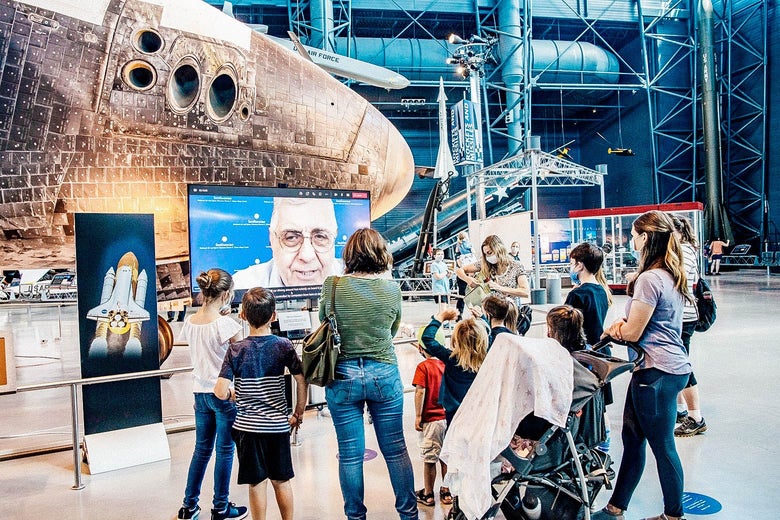
If you’ve never visited the Smithsonian’s Air and Space Museum Udvar-Hazy Center in Chantilly, Virginia, you won’t fully comprehend the sheer cavernousness of the space. The cumulative 346,774 square feet in both hangars houses over 240 aircrafts from every style of aviation imaginable, and thousands of other objects. Combined with its more well-known downtown D.C. location, it is the largest collection of aviation and space artifacts in the world—meaning it offers an unimaginable amount of information for visitors to consume.
Advertisement
In late June a group of friends and I decided to visit the museum for the first time. We were immediately drawn to the Discovery space shuttle, which is prominently placed and spotlighted directly across from the museum entrance. As we admired the impressive ship, we wondered aloud why the black tiles on the ship’s underbelly all appeared to be different sizes with different serial numbers. We turned to a screen in front of the Discovery station to see if the recording on it held the answer. To our immense surprise, the man on screen greeted us in real-time and asked if we had any questions. He explained that each tile on the orbiter was custom sized and numbered, and installed to withstand movement from the ship’s aluminum skin.
Advertisement
Advertisement
Advertisement
That man, Ed, was part of the Air and Space Museum’s Virtual Volunteer Artifact Station Program. When the museum began to readmit visitors at limited capacity in July 2020 after its initial shutdown, the visitor services department struggled with how to effectively bring back their docents while still keeping them safe. In lieu of the normal 90-minute guided group tour, the Smithsonian decided on a relatively simple technological solution: It placed 65-inch monitors at the center’s three most popular locations—the SR-71 Blackbird spy plane, the B-29 Superfortress Enola Gay, and the Space Shuttle Orbiter Discovery—and trained interested docents on how to virtually interact with museum goers through Microsoft Teams. “When you get down to it you think, ‘This is not rocket science. How did nobody think of it before?’ ” Richard Weld, visitor services supervisor at the museum, said. “Nobody needed to think of it before, because it was so easy to have a body in the building.” But as word of the virtual volunteers spread, interest took off—both with visitors and museum docents. Now, more than 150 docents have been trained on being at a virtual station.
Advertisement
The notion of digital augmentation to a museum experience is nothing new—self-guided audio and app tours have been around for many years, and museums continue to increase their offerings of immersive technological experiences. Virtual museum tour offerings continue to rise and, during the pandemic, several even began to use augmented reality to help bring their exhibits to peoples’ homes.
Advertisement
But having live virtual docents available in fixed locations to answer questions brings a new hybrid element to the museum learning experience, one that increases accessibility and encourages even more people to interact with exhibits.
Museum learning is often described as free choice learning—meaning visitors get to choose which works or artifacts to examine, what parts of the museum to visit, and how long they want stay at a station. This caters to self-directed learners, or people whose learning is deeper or more impactful when they’re able to choose what they learn, and how they learn it. The notion of self-directed learning has been part of museum education rhetoric for decades, but technology continually creates new avenues to expand that learning. In a 2017 report on the future of museums, a European Union-founded research group wrote that “we need a technology that does not create a gap between digital natives and the other different kind of audience, but that is ‘responsive,’ able to respond differently depending on the user.”
Advertisement
The Air and Space museum’s virtual volunteers program offers that sort of responsiveness. Instead of passively listening to a guided tour in a group, individual visitors are able to actively seek out answers to their questions. And the one-on-one conversations also tend to lead to offshoot discussions about related artifacts or other objects placed nearby, Weld says. This is what a 2007 Harvard report on museum learning describes as museum staff offering unexpected choice, which “can help visitors expand both their interest in the collections and their perspectives on the works they choose to examine.”
Advertisement
From the museum docent perspective, the program helped to increase accessibility for volunteers, particularly older volunteers who were taking strict health precautions, and those who had to relocate during the pandemic. And for those who can’t handle the physical demands of a 90-minute walking tour, virtual volunteering has been a welcome alternative. “It’s an accessible volunteer option,” Weld said. “And it’s something we’re very, very proud of.”
Advertisement
The program also brings with it the opportunity to bring in renowned experts to discuss certain artifacts, something that has happened internally but has yet to be integrated into the virtual volunteer program. Currently, the Virtual Volunteer Program plans to expand to the downtown Washington museum location when renovations are complete, and will be installing three monitors there when the museum reopens on July 30.
In the meantime, virtual volunteers are available from 10 a.m. to 3 p.m. daily at the Udvar-Hazy Center. And I can attest that they are worthwhile way to learn something unexpected—we spent nearly four hours in the museum the day I visited, and the thing I still remember most clearly is my conversation with Ed about Discovery, and how no two ship tiles are exactly the same.
Future Tense is a partnership of Slate, New America, and Arizona State University that examines emerging technologies, public policy, and society.







